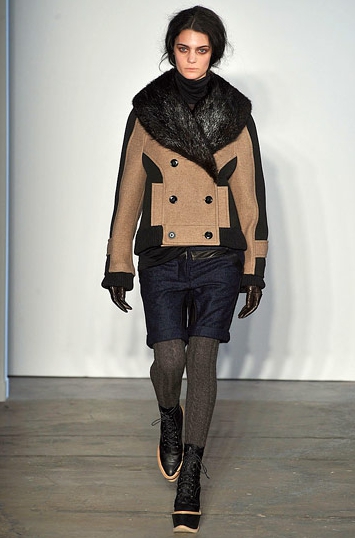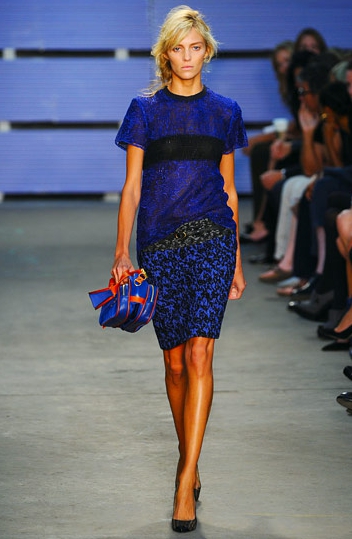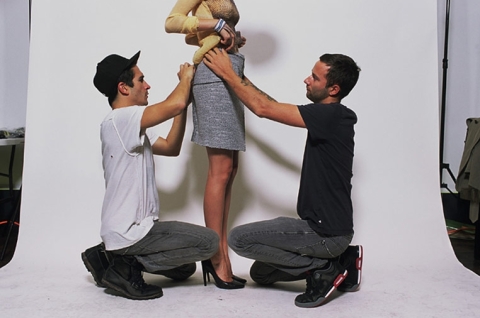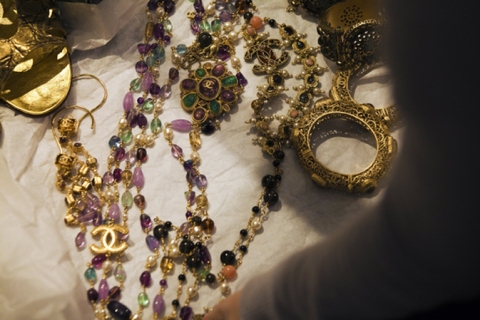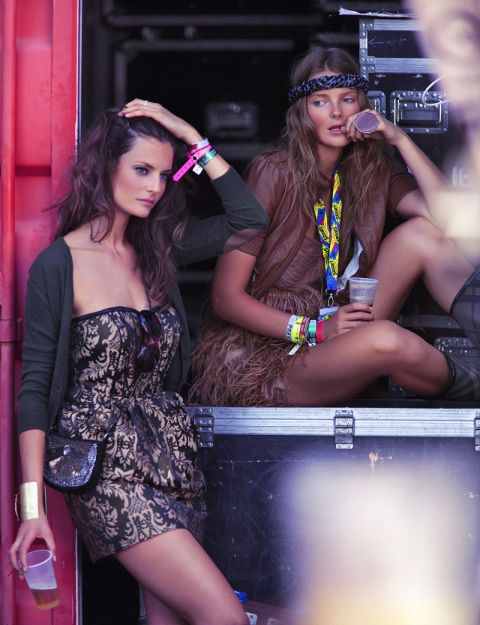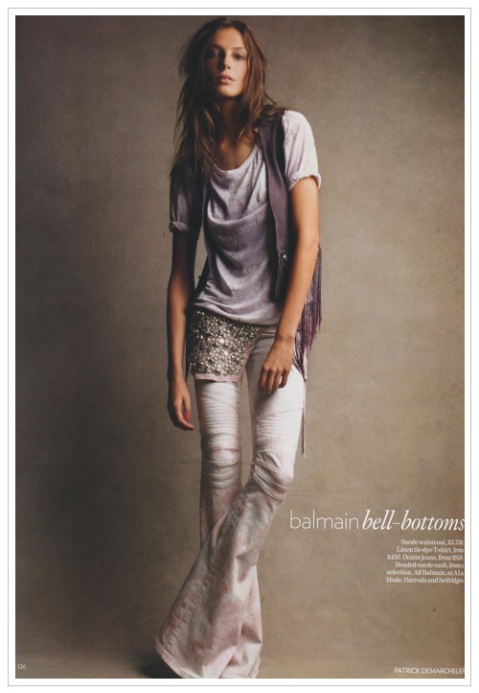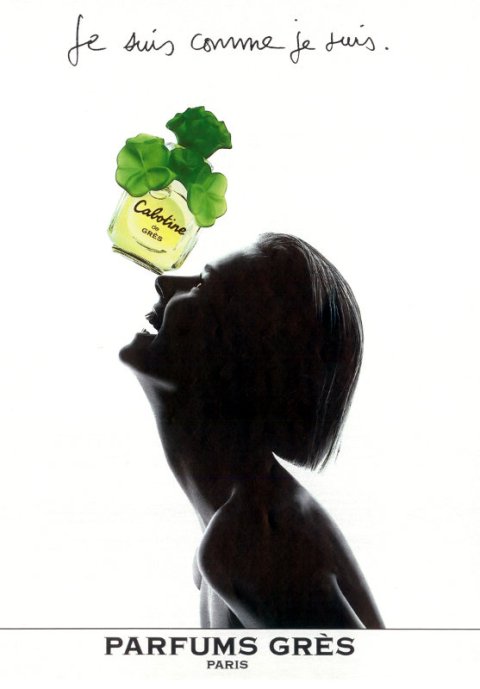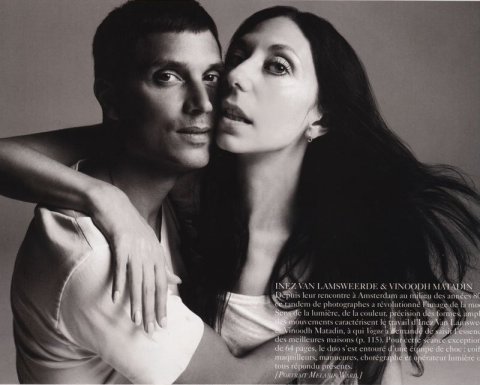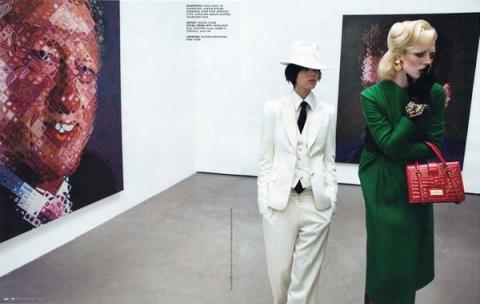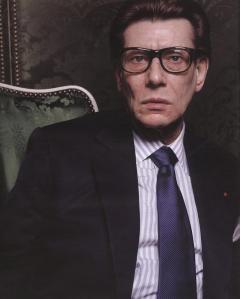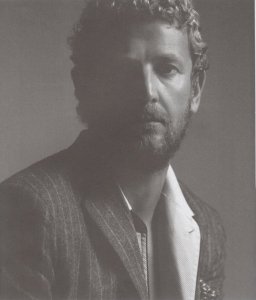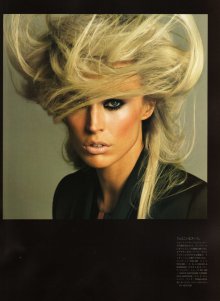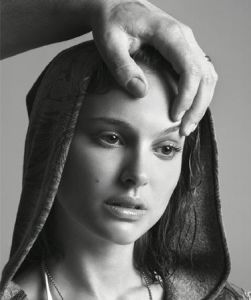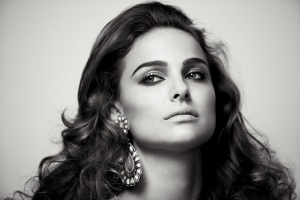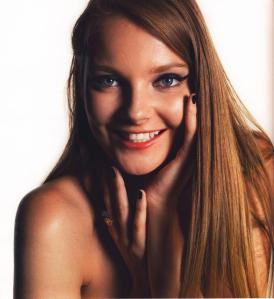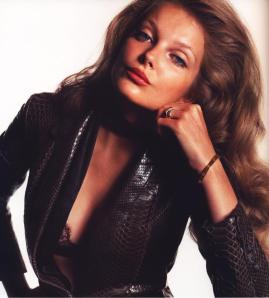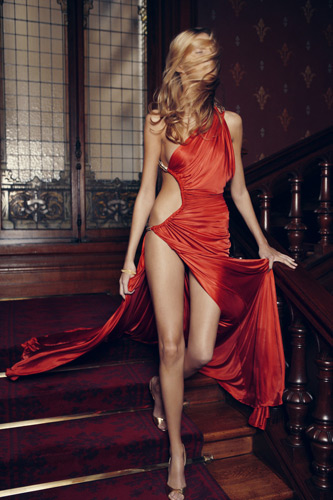Schoul’s cool or the return of mama’s boys
February 11, 2011 § 1 Comment
For a year or two there’s been a lot of buzz about a fashion brand who’s name was absolutely impossible for me to pronounce correct some time ago. In my naïve pre-fashion-documentation years ( I guess this period really exists for most of us), I didn’t know that Proenza Schouler was an American fashion label. It sounded and looked like a brash and cool Italian all the way. Later I found out that behind the casual-cool-luxury collection (inventing non-logical expressions like this makes my day) is not a nice, well-dressed Italian woman, but two guys, sort of skate boys or music dorks, with a strong passion for the nineties, menswear prints and tailoring. Yes, more than bold print combinations, strong or acid colors, Proenza Schouler is about creating defined shapes, playing with tailoring details. The whole online promoting for only some of the label characteristics (from Tavi to Jak&Jill and other fashion blogs or sites) was only the tip of the iceberg, in a good sense.
Mama’s boys, as the name of the brand contains the maiden names of their mothers, met at Parsons School of Design in 1998 and after they collaborated for the senior thesis, they established Proenza Schouler in 2002. Since then a strong breath of youth spread across American womenswear. I’ve always seen American fashion as annoyingly practical, pragmatic with a touch of controlled creativity. Instead, when I turn my eyes towards what’s going on in Europe regarding fashion, everything’s bliss, fantasy, utterly remarkable tailored without being afraid of being unpractical. But I was blind for a while. Now I smile at the sight of cool post-grunge inspired collections, bold layoring, standout accessories, sleek design that sometimes remind me of a cooler and relaxed interpretation of Chanel suits and, of course, bronze, military green, dark blue neutrals.
Thank you, Proenza Schouler.
Proenza Schouler: Jack McCollough & Lazaro Hernandez
Fall 2008
Fall 2009
Resort 2011 (still remains a personal favorite)
SS 2011
Pre-Fall 2011
Photo from Proneza Schouler official website
Sources
Not Istanbul, not so Constantinople
December 20, 2010 § 1 Comment
I don’t have much to say about Chanel’s pre-fall collection, “Byzance”. But that’s not necessarily a bad thing. On 7th of December a part of the Chanel salon on Rue de Cambon, Paris had new clothes on: low sofas, hand-painted cushions, oriental rugs, wood panels on the walls and, of course, the famous reminiscent element of the Byzantine Empire, the mosaic that peeked with shyness from under rugs, on small coffee tables and on garments.
From one of Chanel’s latest travel-trough-time collection (a short trip to Imperial Russia), the Paris-Moscou collection (pre-fall 2009), all the embellishment of the clothes and the opulence of different accessories that reminded or not of Czars and Russians fairies (not so sure if I should call them princesses) gave a clue that Mr. Lagerfeld likes to turn away from reconstructing actual garments from the period of inspiration and play more with accessories, mostly head pieces and other jewels. When I say “reconstruction”, I’m not referring to actually copying patterns, but revisiting some important pieces from that culture or time.
The Paris-Byzance is a mild reconstruction of byzantine clothing regarding patterns. Staying true to spirit or tradition of the house of Chanel, there were two pieces suits, most in tweed, simple black or mostly black dresses, short tailored skirts, three-length-sleeves dresses or jackets. Nevertheless, there were some elements that brought back the Bizantine world: many jackets, upper parts of dresses and tops did have a tunic shape (not the actual dalmatica, but still a tunic), some models were dressed head to toe, as fashion during the Byzantine Empire was that people should hide their body.
What does resemble and revive the whole Byzantine spirit and offers the collection bliss is the craftsmanship with which the embellishment was made: embroidery, stones and metal panels attached to the garments that created variations of the mosaic, small but noticeable head pieces, sandals covered in stones.
Seventies Vibe
December 4, 2010 § 1 Comment
Flowing floral gowns, fringe, bell-bottom trousers, full sleeve, ethnic inspired clothing, natural fabric, long scarfs, hats, round colored lens glasses, embroideries and others.
Roberto Cavalli, S/S 2011
Vogue Turkey, October 2010
Antonio Lopez, Back To Nature, Vogue July 1970
Alberta Ferreti, S/S 2011
Anna Sui, S/S 2011
 Celia Birtwell, fashion designs and illustration 1969/70
Celia Birtwell, fashion designs and illustration 1969/70
Dazed and Confused, May 2010 and Patrick Demarchelier
Elizabeth Suter, Fashion Forecast, 1979
Kenzo, F/W 2010-2011
Numero #117
Sources:
Fashion illustrations from – Blackman, Cally. (2007). 100 Years of Fashion Illustration, London: Laurence King Publishing, 244, 248, 254, 265.
Almost flawless
December 2, 2010 § 4 Comments
Have you ever heard about BSP (Brand Selling Proposition) or MSP (Me Selling Proposition)? It seems like just another way to say that we buy brands, not products or services, indulging ourselves with their atmosphere, values and lifestyles (of course, brands, as people, have lifestyles). Also, some brands are all about us: we can create (actually chose from a pre-existent set of layouts or models) our own version according to our preferences. But that’s not the topic of this post, it’s about how advertising can be for real people and praise them.
Let’s take for example ad prints for perfumes and fragrances. They’re not ordinary products, as they don’t satisfy a basic need, and they involve symbolic consumption. Don’t we choose perfumes according to our personality, self-esteem? An ad for a “small potion of desire” or “small potion of ourselves” has to be highly visual, emotional, evocative, enchanting, convincing, you name it. It has to whisper so many meanings and feelings without ever stating them so that every member of the target can decipher the message as they wish. Most of the times it has to praise the consumer by projecting a perfect man or woman or at least it seems so. Because fragrance can be considered one’s essence or a brief description of that person, its ad can show the consumer with all his/hers flaws without ever failing to impress or stir a negative reaction.
One Million and Lady Million celebrates hedonism and materialism in a comic manner. Of course, fragrances can be worn by people always craving for more or who want to get rich or die trying. This is who they are and that is what their scent most suggest.
Cabotine is for show-offs, the extroverted ones, the ones that aren’t afraid to be too loud, to break a social norm. You can flirt with a married man; it’s actually fun. You can wear a short skirt in your 40s. You can balance a bottle of perfume on your nose at a party even though you’re a respectful lady.
The act of buying and using fragrances is egocentric. We celebrate ourselves when we spray vapors of fine perfume on our skin. The house of Chanel didn’t think twice when it released Egoiste. Only a self-centered, self confident or haughty person can wear it. You’re so aware of our importance that you wouldn’t share anything so personal, as a perfume, with no one. Not even your shadow. Let’s be self-centered. Let’s praise our flaws.
Transgresser
November 6, 2010 § Leave a comment
Pairs Vogue, August 2009
Two decades ago the artistic duo (it would be a bit improper to label them as fashion photographers as their work manages to break down the line between fashion and art) Inez van Lamsweerde and Vinoodh Matadin “ripped” the normal composition of the image destined to appear in a fashion magazine. The models would no longer be shot with the scenery to tell a story, for they used stocked images on a computer as backgrounds for indoors photos which they both simultaneously took from different angles and it was a matter of they that they embraced special image editing. But it wouldn’t be the obvious type of retouching found in many fashion magazine editorials or adverts; it would subtle kind of image manipulation. Almost inexistent to the human eyes at first glimpse, the oddness of the images would pop-up if you looked twice. Inez and Vinoodh became well-known in the mid nineties when British magazine The Face showed several pages with some of their work. After that they took shots for many fashion advertising campaigns, for clients like Gucci, Balenciaga, Yohji Yamamoto, Chloe and editorials for iconic magazines including Vogue Paris and Vogue Nippon, Purple Magazine, W Magazine, Muse Magazine. Of course, there’s a lot to be said about their life, careers, but their biography and portfolio are partially available online. There just one thing to mention: both studied fashion design. Vinoodh actually worked as one and met Inez, at the time a design student who, passionately, began taking photos of her school mates and in short time gave up design for photography. More than just a sneak preview in the industry.
Me Kissing Vinoodh (Passionately), 1999
Me Kissing Vinoodh (Eternally)/ Lanvin Men, S/S 10
Lanvin Men, S/S 10
Going back in time (not to long along though), their exposition at Foam Museum in Amsterdam pretty much summed up their work in art and fashion and gave audience an idea of what has been going on in their heads since their collaboration, both intimately, let’s say, and professional. White walls that seemed either to never end or to stop briefly formed a maze with photographs, linked to each other in order to former a coherent structure. No chronological order. It was a stream of consciousness. Small photos were like full stops or commas, while large, almost gigantic ones stood for the main idea. Me Kissing Vinoodh (Eternally), Me Kissing Vinoodh (Passionately), Me Kissing Vinoodh (Lovingly) placed at the beginning and the end of the exhibition underlined their existence as one person, one stylist, one artist, one photographer.
Art and Commerce, W Magazine, October 2009
Me#03, Foam Magazine, September 2010
They should be mentioned for doing absolutely great portraits of models, actors, designers and other well-known figures. What makes them stunning is the way they play with self-identity or, as Glenn O’Brien said in the introduction of their interview, self-creation. We can be whoever we want in front of a camera, without being fake. Staying true to themselves (maybe because of their strong personalities), all subjects playfully act as the actor, model, designer in Inez’s and Vinoodh’ s mind and help create an ironic, beautiful and sometimes disturbing image. Pretty much everything you want.
YSL, V Magazine, August 2008
Stefano Pilati, Muse Magazine, April 2010
Raquel Zimmermann, Vogue Nippon, May 2010
Natalie Portman, NY Times Style Magazine, S/S 10 and Interview Magazine, September 2009
Eniko Mihalik, Paris Vogue, November 2008
Anja Rubik Descending a Staircase, Vogue Paris, 2005 and Nude Descending a Staircase, Marcel Duchamp, 1912
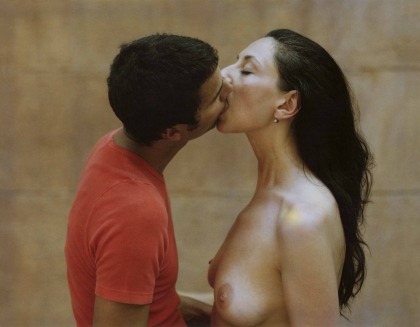 Me Kissing Vinoodh (Lovingly) 1999
Me Kissing Vinoodh (Lovingly) 1999
Bibliography:
“Pretty Much Everything Else” – Inez van Lamsweerde & Vinoodh Matadin in conversation with Glenn O’Brien, 2010
Inez van Lamsweerde & Vinoodh Matadin photographer profile- models.com
Inez van Lamsweerde & Vinoodh Matadin, Foam Magazine #13








